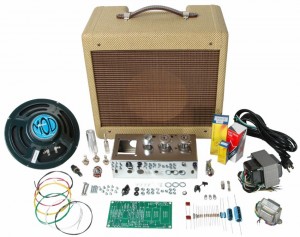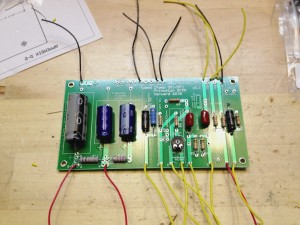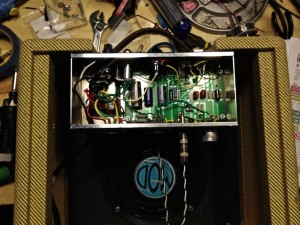 When you make DIY stompboxes powered by 9-volt batteries, your biggest fear is a solder burn (or dropping your drill on your iPad, but that’s another story). DIY amps are different: AC voltage can kill you, so a klutz like me approaches amp builds with caution.
When you make DIY stompboxes powered by 9-volt batteries, your biggest fear is a solder burn (or dropping your drill on your iPad, but that’s another story). DIY amps are different: AC voltage can kill you, so a klutz like me approaches amp builds with caution.
Which brings me to one of the great things about Tube Depot’s Tweed Champ Vacuum Tube Amp Kit: the fantastic assembly manual. Other great things include the price ($499, roughly half the price of a non-kit Champ clone of comparable quality). The design (which follows the original circuit, but substitutes an intelligently designed circuit board layout for the original turret board). And most of all, the tone.
I’ve got lots more to say about the kit, the fun I had building it, the lore of the 5-watt ’58 Champ, and the pros and cons of Class A amps (the Champ is the only Fender classic that merits the classification). But first, have a listen!
The Champ Mystique. Let’s start with the tone. The Champ, with its single 6V6 power tube, is pretty much the only Class A Fender classic. (For a nice, clear explanation of Class A vs. Class A/B, check out this short Guitar Player article on the topic by the ever-reliable Dave Hunter.)
In sonic terms, it translates into the amp’s chiming harmonics — they practically crackle. However, that excitement comes at the expense of the tightness and focus of, say, a blackface Fender.
Another attribute is the circuit’s extreme dynamic sensitivity. You can crank the amp’s single volume knob and control the overdrive from your volume control — or just your touch. I can’t think of another amp that lets you transition so easily from sparkle to splatter solely via finger pressure. It’s expressive and exciting.
Meanwhile, the amp’s modest wattage makes it easy to generate power amp distortion at relatively low volumes. When you crank it, it doesn’t sound like you’re playing through a distortion pedal. It sounds like the amp is about to explode.
That great tone and thrilling dynamic response have made the Champ not only a beloved practice amp, but a favorite studio tool as well. Many players have conjured big, big sounds from this little box — and none more famously than Eric Clapton and Duane Allman on the Layla album (though sources disagree about whether they used tweed Champs, silverfaces, or both).
The Tube Depot version. I’ve never owned a vintage tweed Champ, but I’ve been lucky enough to spend quality time with several pristine originals, and this kit version puts you right there. It adheres to the original circuit, but relies on a circuit board in lieu of the original’s turret board. While this has no bearing on the sound, it makes construction faster and substantially more idiot-proof. Likewise, the amp uses no arcane or NOS parts — just quality modern components equivalent to what you’ll find in many boutique amps. Same with the substantial cabinet and hardware. The speaker is an 8″ Jensen MOD. The wire is modern stuff, not vintage-style cloth push-back. (While they don’t advertise it on their site, Tube Depot also sells a turret board version of the kit on request.)
I’m a massive sceptic about most “mojo” parts, and I certainly can’t find fault in the way these modern components perform. Yes, a 55-year-old amp sounds different, but I suspect that has more to do with time-worn parts than with some overpriced capacitor.
Building it. Besides, details like that don’t matter much if you can’t build the thing, right? And that’s where Tube Depot’s kit really shines. I’d previously built two kits from Ceriatone, clones of a blackface Vibro Champ and a Marshall 18-watt. They turned out fine — but Ceriatone, like most other clone vendors, offers only bare-bones assembly help. But Tube Depot’s Rob Hull has crafted a superb 40-page manual with precise instructions and copious photos. (You can check it out here.) It never feels like you’re building an IKEA end table with a name like “Snørker.” Hull goes out of his way to provide interesting details, savvy assembly tips, and basic electronics info suitable for first-time builders.
The project design promotes a tidy build. The clever circuit board layout positions all wires as close as possible to their off-board destinations. The guide specifies ideal wire lengths. My Champ build is far from perfect, but I’m not ashamed to post a pic of it here, which is more than you can say for my previous DIY amps.
For a former middle-school shop class dunce like me, the trickiest chores were mechanical, like drilling holes in the cabinet and chassis. I cleverly managed to screw up a couple of measurements, but it was nothing that an extra hole or two couldn’t fix (plus some large washers to hide the scars).
Conclusion. I’m thrilled to bits about the way this amp sounds, looks, and feels. I can’t wait to record with it. (I’m especially eager to try it out as the top layer in a “tone sandwich” with a darker, tighter amp shoring up the lows.)
The build was a blast. This would make an excellent first amp project (though if you’ve never attempted any DIY electronics, I’d make a few simple stompboxes before tackling an amp). The documentation sets the gold standard for DIY amp kits. It not only increases your odds of successfully completing the kit, but prepares you for all those other DIY kits that lack such fastidious instructions.
If soldering an amp together sounds like your idea of a Saturday well spent, I highly recommend this great-sounding, thoughtfully conceived kit. It’s an excellent way to tap into an iconic amp sound at a decidedly sub-iconic price.
(DISCLOSURE: Tube Depot provided a free kit for this review.)











I also recommend making a Champ-clone. I built one from the Weber-kit, a little more based on the old style setup and wiring, but I’d bet it sound similar.
One thing I immediately noticed is how *different* every pickup on every guitar sounds. It’s pretty incredible, and it makes it difficult to choose the right sound if you are using it to record!
Super fun to build your own amp. This one is an afternoon’s job!
Yeah, you’re right. The circuit is so minimalist and naked, you definitely hear maximum character from the guitar and pickups. If I’d had a little more time, I’d have included some other guitars in the demo video — especially since many players would probably prefer the sound of a humbucker through this bright, sometimes glassy amp. But I just WENT for it, playing hard on a bright guitar’s brightest pickup. Why pussyfoot? 😉
Great job Joe….after receiving my AAS Electrical Technician degree..I have really enjoyed the circuitry and understanding of these power amps..Class A and Class A/B and the differences of what you can get with which tubes 6L6’s EL34’s..Definitely worth investing in this kit to have a Champ. Great tone and sound.
Joe, what made you choose the TubeDepot kit over others, like the Weber or the MojoTone?
It wasn’t a very scientific choice. They asked. 🙂
Sounds great Joe. Nothing quite like a Champ, and this kit sure sounds (and behaves) like one to me. Imagine how sweet it’ll be when the speaker has a chance to break in!
It would be interesting to do a comparison with the current crop of micro-tube amps from Fender, Gretsch, Vox, etc. Most of those go for about $200 here in Canada, which is considerably less than this kit and gives a guy some wiggle room for speaker replacement or other mods.
I’m also interested to learn a little more about those Mod speakers; I may have use for one in one of my SS combos.
I have one of the Gibson GA-8’s mentioned in the Guitar Player article, and I can definitely say I love the simple circuitry of small class-A amps. Riding that great place between the amps chimey clean and its raunchy drive is a great feeling. The breathtaking dynamics have all but ruined me for most of the pedals out there.
I’ve watched some of Tube Depot’s videos and looked at their site, and I was refreshed with their simplicity and clarity. They are great communicators and teachers. I’m with Joe and the Depot guys in avoidance of mojo. Take the best of our modern technology and marry it with the great sounds available from this simple circuit from the past.
I have a GA-8T that I’ll probably take to my grave- I LOVE that amp! I also have a GA-5 that’s almost identical to a tweed Champ. Back in the day, the tech at the shop I worked at recapped it, and put in larger coupling caps, ’cause back then everything had to be distorted to the maximum. Plugged it in for the first time in months the other day, and now I’m thinking I might actually like it to not be full-on distorto at ”3”. Yikes!
Great review both the article and the vid!!! I was waiting for it since you said you’ll make a review on the DIY-Amp kit. I’m guessing for a beginner the most hardest part may be drilling everything at the “Precise” positions isn’t it?
That sounds wonderful! Very nice for the price I would say , especially if it plays well with pedals.
I’m curious—have you gotten a chance to try this amp through any other speakers? In my experience, the sound of these little amps has a lot to do with the small, low-wattage speaker. I’ve always wondered how a amp like this would fare through something similar to my old 150w EVs, perhaps the most ungodly loud, tight & clean speakers I have ever heard (which I loved, much to the chagrin of my bandmates).
I used to have an Epiphone Electar Tube 10, which is kinda somewhere in between a tweed and blackface Champ laid out triode stage–>gain knob–> triode stage–>treb/mid/bass tone stack and master volume–>single-ended 5881 output stage. Sounded *very* nice through an EVM-12L-loaded Thiele cab. “Meh” through the junk speaker in the junk cabinet that it came in, though.
Thanks, very helpful article. I'm getting ready to build my first amp and want to do a Champ-clone. As a first-timer the 49 page manual and printed circuit board offered by Tube Depot is proably more helpful that the 5 page Mojotone instructions.
I wouldn’t put that much stock in manual length. There are probably not even 49 electronic componets in a Champ. there is also a ton off web sites that have all kinds of data on Champs. Take your time, try to have a workplace that can be kept set up tilll the kit is done. lay out the parts, have really good lighting and a comfy chair.Get a good temperature controlled solder station with plenty off power, don’t skimp on the solder station. Bad solder connections are a big source of problems in kits especially on pc boards. You might want too consider getting a couple of cheap kits to put together first, like cheapo led displays or toys to practice soldering on a PC board. my choice would be for a turret board based kit rather than PC board it makes repairs and mods easier. Get some 2% silver bearing solder (Radio Shack, all good electronic suppliers have it)) this solder wets better, does better with a variety of metals even allows you to solder a ground to a steel chassis much easier. Take your time don’t rush and ask questions.
+1 on getting a good solder station (i.e., spending more like $60 than $15). It makes everything SOOO much easier. And some tasks — like heating up the back of a guitar pot to affix a grounding wire — are nearly impossible with a cheapo iron. Two good sources for beginner projects are Make magazine and Spark Fun electronics. BYOC, whose stompbox projects I adore, also does a nice little “confidence builder” kit.
Joe,
Thank you kindly for the very helpful review
I bought one of these kits and I’m about 90% complete with the project. Rob Hull at tube depot has been sooo helpful in the building process. I’d recommend this kit to anyone considering taking on a project like this. I can’t wait to play my fat strat Texas special with brand new Fender 57/62 single coil pickups through this beauty.
I chose to lacquer the tweed on this cabinet with polyurethane. Per Rob’s advice I used 4coats of PU and it now has a beautiful aged look that will last a lifetime. I sanded the PU between each coat with 200 grit paper. It’s gorgeous. Anyone who buys this kit should do the same. It looks great with the PU coats.
Thanks Joe and you awesome guys at tube depot!!!
Add another review with a hum bucker and a choice pedal if you get a chance.
i am almost ready to attempt this project.i thought about doing the deluxe kit but this one may be the place to start.
Hi Leonard. You won’t find a better “first build” kit than this one. I wish I’d done it before attempting a couple of trickier ones. They turned out okay — but they’d have been better if I’d started here. It’s a cool little amp!
Update to jan 4th posting. My bro and I took our sweet time with this project but we completed it recently. The build is relatively easy. I’d suggest using Rob Hull’s excellent manual along with his cartoon schematic to give yourself the best chance of success. Use a practice circuit from Amazon to be sure you know how to solder first. Use a 40W solder gun and “leaded” solder. I lacquered the tweed with urethane. Now it’ll last forever. If you’re kind of electronically challenged, figure it’ll take 20-30 hours to complete. The build is straightforward but some of the steps are a bit tough to follow. Most will be able to get it right the first time.
The sound is fricking amazing, it is better than we thought it would be. I love it. Think zz top Tush or joe Walsh on Funk #49. it’s awesome. I should note that the clean headroom is quite low. That goes without saying, but I was surprised how low volume the clean actually is. Consider a speaker upgrade to an eminence 820H. Ensure you choose 8 ohms from the OT to the speaker jack if you do. BUILD THIS KIT!!!
Hi Tim — great advice! An I’m not just saying that ’cause I agree with all your comments. :)_
A bit surprised to see Eric sporting a Hello Kitty-guitar …
I know! It IS a surprise! A lot of people think he played Gibsons and Fenders.
I built one of these myself last weekend with my son who is an EE major in college. (Who largely kept me from doing dumb stuff) Went off pretty well but I don’t get much distortion out of this. Did you by chance disable the negative feedback circuit on yours? I’ve tried all the tricks of turning up everything on the guitars and amp, but it still sounded pretty clean.
Oh man — I wish I’d had an EE to help me build mine, especially one who works for free. 🙂
No, I didn’t do any departures like that — it was strictly by the manual. It should sound pretty darn distorted at high settings, maxing out at a harsh, glassy crunch that you’d probably rarely use.
My first suggestion isn’t much fun: Open it up to reveal the circuit board, and double-check the value of every component. Check the cap values, and verify that every resistor is in its proper place. (Consult a resistor color-code chart.) My first guess — and it’s only a guess — is that two resistors got swapped. Just because that’s SUCH an easy mistake to make.
That was my guess too. Sigh… Time for a check.
Hi. Good job. I am building a Champ and am looking forward to its incredible sound. My current challenge is that I have a Mojotone cabinet that has not been pre-drilled for mounting the chassis.
Do you or any of your readers know where there might be a template availabile for where the wood is to be drilled? I can measure and such but carpentry is not a strong point with me. Any response from you or your readers would be much appreciated!
For the rear screw holes you could put a sharp object in the screw holes. Then position the chassis in place with the rear end down and when it is where you want it press the rear of the chassis upward until it makes marks in the cabinet. As for the front side you could insert the sharp objects in the front holes of the chassis and then flip it upside down and line up the rear holes then push the chassis on the front to mark the cab. It might be even easier if the chassis is made like the old Fenders where the used long bolts with nuts. In which case put the chassis in place and clamp it then use an ice pick or awl to mark the holes. If you are drilling from the inside of the cab drill most of the way thru and use the awl or ice pick to go the last bit then finish from above. One point to keep in mind it is best to make the hole in the covering with a hand tool like and awl or punch as a drill made damage the fabric whether drilling from above or below. Good luck and remember it’s only rock and roll not rocket science even Fender stuff wasn’t always perfect.
I didn’t realize it was a tweed. I was thinking blackface. You should be able to clamp the chassis in place and mark the holes with a awl or icepick maybe even a fine tipped marker. Again tho’ drill carefully with a smaller bit and not all the way thru then finish with and awl or icepick to find where they come thru the top. Use something other than a drill to make the hole in the tweed as a drill might grab the fabric and make a mess.
Link to Tube Depot amp kit is Here: https://tubedepot.com/products/tweed-5f1-vacuum-tube-amp-kit—big fan of Joe Gore! I may try my unsteady hand at this amp kit soon!
Greetings from the Emmylou Harris Summer 2017 tour—what a great gig for a guitarist and singer like me! I get to play roots music AND space atmosphere and get down and dirt w/ a Germanium fuzz…Emmylou is the best!
Hi Will! I totally know who you are. What a cool gig playing with EH! (I only met her once, but man, was she cool.)